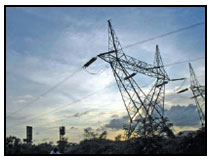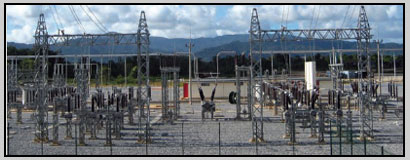
Electricity is an essential
requirement for all facets of our
life and also it is the main one of
the key divers for rapid economic growth
and poverty elevation of the nation.
Keeping this factor in mind and also the
shortfall in generation addition plan in
the earlier five year plans, it was
targeted to add 78,700 mw of power
generation capacity for the XI Plan with
cumulative capacity touching 2.2 lakh
mw. As against this, the cumulative
achievement was 1,81,558 mw as on
August 30, 2011.
Even with the best effort further
addition may be around 15,000-20,000
mw by the end of the XI Plan period.
Even then, there will be a shortfall of
about 25,000-30000 mw. Even if the
entire 78,700 mw were to be achieved, it
was planned that 1,03,000 mw of
further generation capacity would be
added in the XII Plan period. The
indicative fund requirement or
transmission system development and
related scheme is expected to be

2,40,000 crore, including

1,40,000
crore in the Central sector and

1,00,000 crore in the private sector.
The investment requirement for the
power distribution sector would be to the
tune of

3,71,000 crore.
So from the above it is very clear there
is a huge investment potential in the
development of transmission and
distribution infrastructure upgrade.
EVOLVING T&D SCENARIO
Opening of transmission sector for private
entities and competitive bidding process it
was expected that there will be infusion of
new technology and also competitive
pricing. Accordingly everyone who had
stakes in the power sector lined up enough
capacities further to go on and strike the
opportunity. The regulator and
government policies are in place
favourably for generating competitive
bidding and these opportunities did
come as expected. But what begin with a
little undercut in tender soon became a
massive erosion of prices of equipment
and execution.
The downslide has not yet been arrested
and the price-war continues because of
grabbing business and one-upmanship.
The bottom lines of all companies are
likely to be hit.
Due to the above scenario it is not
expected that coming power T&D
infrastructure will be technologically
more advanced due to private
participation. As advanced
technology in the form of different
structures including is costly, so is the
technically advanced methodology of
erection. Besides the qualification
requirement allows any EPC
contractor with any type of project
experience like road, real estate,
railways, irrigation, etc, having
financial capacity can participate in
the competitive bidding process.

Mostly the tenders so far floated have
been captured by agencies that have no
adequate exposure on building up of
transmission sector. Agencies that had
adequate technical background could not
compete with those bidders due to their
competitive pricing. The bidders who are
exposed to the technological area of the
transmission line could have contributed
more. The base-pricing worked out for the
various transmission line by the CERC is
much higher and those prices were also
calculated on the conventional design and
erection practice prevailing in the present
Indian context. So we do not expect that if
the QR requirement and price war is
not changed, there will be any
technological advancement in the
upcoming T&D infrastructure even after
opening the same to the private entities
through competitive bidding. Besides in
absence of specifically-defined detailed
specification, strict supervision by third
party, bidder may try to construct line
with specification which will match their
project costing and may comprise
reliability and security of the transmission
line in the long run.
T&D LOSSES
T&D losses including unaccounted energy
are about 30 per cent there is need to
reduce these losses through efficient
management and the best O&M practices
in the T&D system. Only this will ensure
that more energy is made available to
ultimate consumers at reduced cost.
However, if the situation continues as in
the present, the proposed investment in
the power T&D sector in the XI Plan
period will vanish into unknown space.
This loss will be in addition to earlier
incurring losses. If the losses are not
controlled on war-footing, private
investor will loose their interest in this
sector and the financial health of utilities
will go on deteriorating.
The T&D losses 30 to 40 percent will act
as a major deterrent to the private as well
as global investments in the sector. So far
none of the global power major has shown
any interest in India's T&D sector. The
17th EPC published by CEA has targeted
to bring down the T&D loss to 22 per cent
in the year 2011-12 which much higher
than the developing nation life chain (e.g.
in Thailand, it is 10-12 per cent.)
So to mitigate the problem we have to
identify the cause. Principally the losses
can be categorized as:
- TECHNICAL LOSSES
- Overloading of existing lines and
substations
- Too many stage of transformation
- Absence of upgradation of old lines and
equipment
- Improper load management
- Low HT : LT ratio
- Poor repair and maintenance of
equipment
- Non installation of sufficient capacitors
- COMMERCIAL LOSSES
- Low metering/billing/collection
efficiency
- Theft & pilferage and tapering of
meters
- Low accountability of employees
- Absence of energy accounting &
auditing
- Bypassing the meters
- Changing CT Ratio and reducing the
recording
- Improper testing and calibration of
meters
REDUCING T&D LOSSES
To reduce the T&D loss following
initiatives are needed:
- Energy audit at all 11kV feeders
- Full metering of all consumers
- Un-bundling all SEBs
- Commercial viability to be achieved
through
- Profit center
- Franchises
- Privatisation
MEASURES FOR REDUCING
TECHNICAL LOSS - Identify the weakest areas in the
distribution system and improve
- Reduction in line length & relocation of
distribution transformer
- Providing lower capacity distribution
transformer for small group of
customer
- Avoid grouping of transformer
- Use distribution transformer which are
having lower no load losses such as
amorphous core transformer
- By changing equipment, introducing
shunt capacitor and timely
implementing proper preventive
maintenance will bring down the loss
- Over loading line & sub-station is to be
avoided
- Adequate investment in T&D system
should be brought immediately

Many of the actions suggested are
being adopted by some utilities but to
solve the problem every utility should
at least initiate action for technical as well as commercial solution. The
Central Government has come forward
with help in the form of various
schemes like APDRP, RGGVY to
improve the system technically and also
waive / securities all the past dues to
central sector. It is high time for the
utilities to utilize the opportunities for
reducing losses in T&D sector.
Otherwise, the power sector's problem
will continue.
Untitled Document
Growth of power transmission sector in India |
In 1951, when new power generation
plants were set up, they were designed to
supply loads to their immediate vicinity.
Post-1951, with a view to improving
reliability and economics, these individual
transmission systems were interconnected
leading to the formation of state grids.
In
the 1960s, a decision was taken to create a
regional grid as the basic unit for power
planning. For this purpose, the country's
power system was divided into five
regions-eastern, northeastern, southern,
western and northern.
In the 1980s, a stage came when it was felt
that regional grids were not sufficient. It was
mooted to have a National Grid that would
essentially enable transfer of power from
power-surplus regions to deficient ones. It
would also enable optimal balance of coal
and hydropower resources in overall national
interest. Besides, the National Grid was seen
to be a means to improve the economy,
reliability and quality of power supply.
With aim to build a National Grid, Power
Grid Corporation of India, designated as the
Central Transmission Utility (CTU), was
established. Today, except the southern
region, the entire country's power system is
working in synchronous mode and by the
end of XI Plan, the interregional power
transfer capacity is expected to be 38,000-
40,000 mw. The ultimate aim is to run the
entire country in a single synchronous
mode. The national level planning of 100
GW of capacity addition was found to be
equivalent to 113 GW on regional basis. 
|
The development of transmission and
distribution system as turnkey solution
comprises of activities like setting up of
long-distance high power carrying line
(bulk transmission lines) which are mainly
in categories of EHV/UHV; and T&D lines
of the HV/LV variety.
CRITICAL ISSUES
There are several critical issues in the
development of system studies. Firstly,
there is mismatch between the load
centre and geographical distribution of
exploitable energy resources. Coal
resources are mainly in Bihar,
Jharkhand, Bengal, Orissa,
Chhattisgarh, etc. and hydro potential
is in the north, east and northeast
regions. The critical question is how to
create a single reliable power network
for a country as big as India. Other
issues are: is the transmission system
adequately designed with reference of
reliability and quality; what is the
inter-relationship between generation
and transmission reliability; what is
the acceptable level of consumer
service reliability; and how does on
correlate generation and transmission
of bulk power transmission to
reliability in distribution.
The answer to these critical issues is to
first develop a plan for both for long term
and short term expansion programme. To
resolve the plan we should resort to long
term expansion planning; medium-term
expansion planning; short-term
planning; and adoption of most suitable
technical options.
Now we have dealt the planning
problem of transmission system.
Distribution problem and losses have
clearly brought and in earlier question.
Transmission loses are well within the
internationally acceptable limit.
(Swapan Kumar Datta is CEO, EMC
Academy Ltd and Advisor, EMC Ltd.
Datta has over 37 years of experience
in the power sector having held senior
positions in public sector entities like
NTPC and Power Grid Corporation
of India Ltd. He also has rich
experience in training engineers in the
power sector.)